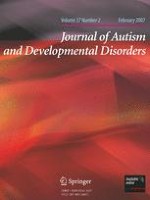01-02-2007 | Original Paper
Priming the Meaning of Homographs in Typically Developing Children and Children with Autism
Gepubliceerd in: Journal of Autism and Developmental Disorders | Uitgave 2/2007
Log in om toegang te krijgenAbstract
Two explanations for deficits underlying autism were tested: weak central coherence (WCC) and executive dysfunction. Consistent with WCC, Happé (British Journal of Developmental Psychology 15 (1997) 1) found that children with autism failed to use sentence context in pronouncing homographs. In an alternate approach, we investigated whether children with autism can use meanings of related word primes. We presented children with autism and controls with primes for homographs, semantically related, and unrelated targets. Children with autism used primes to correctly pronounce homographs upon first presentation but showed difficulty inhibiting prior responses upon later presentation of the homographs with different primes. Children with autism also showed semantic priming effects. We conclude that children with autism do not show an absolute deficit in ability to use contextual information.
